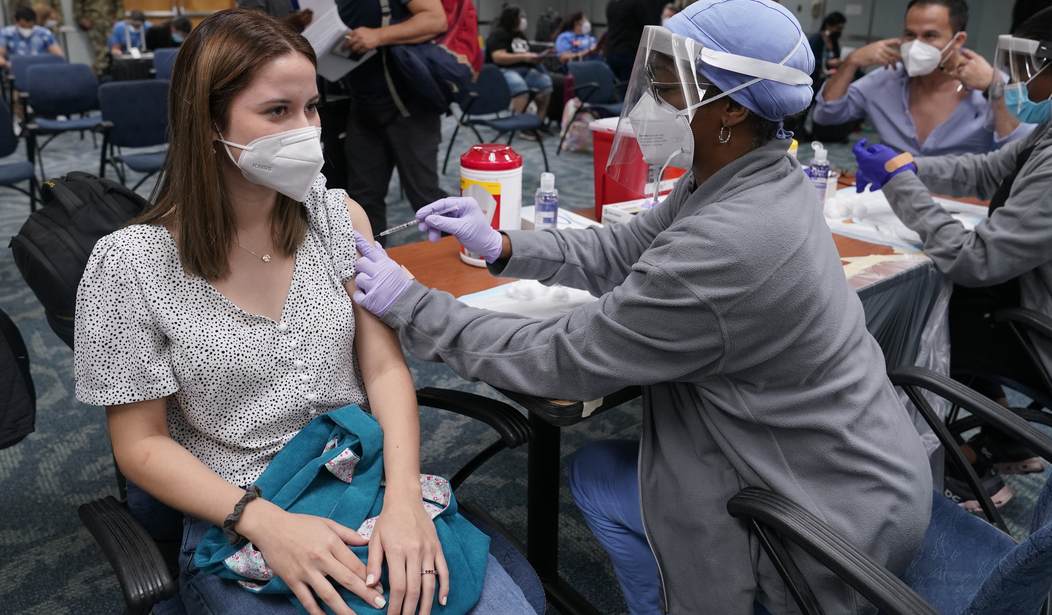This is hard to believe, although I’m guessing one’s skepticism about the number is directly proportional to one’s risk-aversion towards COVID. If you’re vaxxed, masked, and still spooked about Delta, you may calculate your odds of infection as being, oh, one in three or four. If you’re unvaxxed, unmasked, and living life, you may believe the vaxxed have the same tiny odds of infection that you do.
Although … the unvaccinated don’t really believe their odds of infection are small, do they? They believe their odds of becoming *seriously ill* are small. They don’t care about infection.
Anyway, David Leonhardt’s calculations are based on one’s odds of becoming infected on a given day. Over the course of a year, the probability will grow. His bottom line: If you’ve had your shots, your risk of infection is about the same as your risk of a car accident.
The estimates here are based on statistics from three places that have reported detailed data on Covid infections by vaccination status: Utah; Virginia; and King County, which includes Seattle, in Washington state. All three are consistent with the idea that about one in 5,000 vaccinated Americans have tested positive for Covid each day in recent weeks.
The chances are surely higher in the places with the worst Covid outbreaks, like the Southeast. And in places with many fewer cases — like the Northeast, as well as the Chicago, Los Angeles and San Francisco areas — the chances are lower, probably less than 1 in 10,000. That’s what the Seattle data shows, for example. (These numbers don’t include undiagnosed cases, which are often so mild that people do not notice them and do not pass the virus to anyone else.)…
In Seattle on an average recent day, about one out of every one million vaccinated residents have been admitted to a hospital with Covid symptoms. That risk is so close to zero that the human mind can’t easily process it.
That shakes out to a seven percent chance of being infected in a given year if you’re vaccinated. If you’re not, the odds are much higher. By the end of August in Seattle, notes Leonhardt, infections among the unvaccinated had surged from one per 10,000 residents earlier in the summer to nine in 10,000 while infections among the vaccinated remained under one per 10K. The states with the lowest vaccination rates also had four times the infections per capita of the most vaccinated states this summer (although I wonder if there’s a seasonal effect in that, since the least vaccinated states are southern and just experienced their annual summer wave). If in fact the average vaccinated person now has a one in 5,000 chance of being infected, that would also jibe with Delta being considerably more transmissible than previous strains of the virus. After all, before the new variant arrived, the CDC was seeing a rate of one in every 11,000 vaccinated people getting infected.
Ashish Jha thinks the odds of a vaccinated person being infected on a given day are one in 5,000 at worst:
.@DLeonhardt does some math
He suggests that the risk of a breakthrough infection on any given day is about 1 in 5000
I think its closer to 1 in 10,000
And if you live in a lower infection state like MA or RI, its probably closer to 1 in 20,000https://t.co/lMJO3yL6zb
— Ashish K. Jha, MD, MPH (@ashishkjha) September 7, 2021
That’s great news. And if it’s true then the CDC should have been much clearer in presenting the risks of infection to Americans back when it chose to scare the sh*t out of everyone in July with the Provincetown study, which became the basis for its new guidance that the vaccinated should start masking again. The P-town data suggested that the vaccinated could carry the same viral load as the unvaccinated (at least for a few days), which some Americans seem to think meant that the vaccinated are now at the same risk of infection as the unvaxxed. That mistaken perception may have caused major economic consequences as the vaxxed started taking fewer risks again.
The reversal on masks didn’t do any favors for the CDC’s credibility with the public either:

So why does the one-in-5,000 figure seem implausible? Methodologically, it’s because the CDC stopped tracking “mild” breakthrough infections months ago and many vaccinated people probably aren’t bothering to get tested anymore. The whole point of being vaxxed is not having to worry (much) about COVID; if you come down with the telltale symptoms, you may tell yourself “I’ll be fine in a few days” and ride it out. The unvaccinated don’t have the same luxury since the onset of symptoms in their case may be the start of a severe illness, in which case they’d want to be diagnosed and treated ASAP. So the official number of cases may be missing tons of breakthrough infections.
Another possibility: Because the vaccinated are more risk-averse towards COVID, I’d expect they’re more likely to have rapid at-home tests on hand in case they get infected than the unvaccinated are. An at-home test doesn’t get logged in any official database, though. So a vaxxed person may find out that they have the virus through “unofficial” means while the unvaxxed, who are less likely to have a rapid test stashed away, will have no choice but to go to CVS or Walgreens to get tested and end up having their infection recorded. That will also skew the ratio of cases between the unvaccinated and the vaccinated.
There’s a behavioral difference between the two groups too, of course. Poll after poll has showed that the vaccinated are more willing to take non-pharmaceutical precautions like wearing masks or socially distancing than the unvaccinated are. The Seattle figures cited by Leonhardt aren’t a comparison of infection rates between the vaxxed and unvaxxed while doing the same activities. They’re a comparison of infection rates when each group is left to its own devices. That almost certainly means the vaccinated went to fewer restaurants, bars, parties, and so on than the unvaccinated, which means they had fewer opportunities to get infected. To which one might say, “Well, who cares? The one-in-5,000 figure is what it is, even if it’s not entirely a function of vaccine immunity.” Fair enough, but it means that if Leonhardt’s vaccinated readers took his advice to chill out a bit about their personal risk and began socializing more like the unvaccinated do, their odds might begin to shrink.
Then there are the anecdotal reports that don’t seem to match Leonhardt’s math. Some of the replies to Jha’s tweet above include people saying they personally know three or four others who’ve had their shots but got infected this summer. I wrote last month about the case of a Johns Hopkins epidemiologist who attended a house party with 14 fully vaccinated friends and 11 of them ended up getting infected. In the Provincetown study, nearly three-quarters of those infected were fully vaccinated, a function of Massachusetts’s very high vaccination rate.
Does that prove that Leonhardt’s math is wrong? Not necessarily. It could be that the average vaccinated person doing average things has a one-in-5,000 chance of getting infected on a given day. But maybe socializing in a group of any meaningful size cuts those odds drastically — which would further suggest that the risk-averse behavior of the vaccinated is a major factor in why their infection rates are so much lower than the unvaccinated’s are, not just their vaccine immunity. As the vaxxed start behaving a bit more like the unvaxxed, infections surge. Which may mean that the CDC’s new mask guidance wasn’t a bad idea after all.
I’ll leave you with this Twitter thread from virologist Trevor Bedford, who’s been studying the spread of Delta and the variants that are already deriving from it. Delta spread *remarkably* quickly around the world, Bedford notes, in which case one of its sub-variants is likely to become the next threat. So Pfizer and Moderna should pick up the pace on a new vaccine that targets Delta specifically. The more tailored our immunity is to that variant, the less of a threat its sub-variants will be.
At this point, it seems highly likely that the next impactful variant will emerge as a sub-lineage from within Delta diversity, bearing additional mutations on top of Delta's mutations. Consequently, I would urge that the regulatory process for vaccine updates begin. 12/14
— Trevor Bedford (@trvrb) September 7, 2021








Join the conversation as a VIP Member